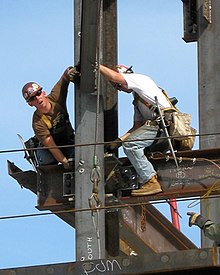 Building a bridge like this is a common ironworker job. | |
| Occupation | |
|---|---|
Occupation type | Vocational |
Activity sectors | Construction |
| Description | |
| Competencies | Heights, patience, steady hand, ability to read plans, physically strong |
Education required | Apprenticeship |
Fields of employment | Construction |
Related jobs | Carpenter, Electrician, Plumber, Welder |

An ironworker is a tradesman who works in the iron-working industry. Ironworkers assemble the structural framework in accordance with engineered drawings and install the metal support pieces for new buildings. They also repair and renovate old structures using reinforced concrete and steel. Ironworkers may work on factories, steel mills, and utility plants.
A structural/ornamental ironworker fabricates and erects (or even dismantles) the structural steel framework of pre-engineered metal buildings, single and multi-story buildings, stadiums, arenas, hospitals, towers, wind turbines, and bridges.[1] [2] Ironworkers also unload, place and tie reinforcing steel bars, (rebar) as well as install post-tensioning systems, both of which give strength to the concrete used in piers, footings, slabs, buildings, and bridges. Ironworkers load, unload, place, and set machinery and equipment as well as operate power hoists, forklifts, and aerial lifts. They unload, place, and fasten metal decking, safety netting, and edge rails to facilitate safe working practices. Ironworkers finish buildings by erecting curtain wall and window wall systems, stairs and handrails, metal doors, and sheeting and elevator fronts. Ironworkers perform all types of industrial maintenance as well.[3]
Historically ironworkers mainly worked with wrought iron or cast iron, but today they utilize many different materials including ferrous and non-ferrous metals, plastics, glass, concrete, and composites.
An ironworker is distinct from a blacksmith, which is someone who works with, shapes, and tempers raw iron.
- ^ Len F. Webster (1997), The Wiley Dictionary of Civil Engineering and Construction, Wiley-Interscience, ISBN 0471181153
- ^ M.Y.H. Bangash (2000), Structural Detailing in Steel, Thomas Telford, ISBN 0727728504
- ^ "Careers". www.ironworkers.org. Archived from the original on 2011-11-28. Retrieved 2009-04-07.
